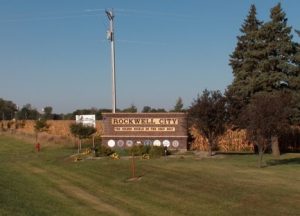Surroundings: Community Gateways
Community gateways are landscaped sign installations that announce to motorists that they are entering a community.

Community gateways are simply landscaped sign installations that announce to motorists that they are entering a community. Gateway signs provide an indication to motorists that they are leaving a rural area and entering a city or town where land use, pedestrian, and motor vehicle activities will be more intense. Motorists should, in turn, respond by slowing down.
A community gateway should be placed where a reduction in traffic speed is desired; it should be close to the boundary of the community. Gateways would best be placed in the speed transition zones where a gradual reduction of speed is desired. The gateway needs to be large enough to attract the attention of drivers while being formal enough to communicate that the character of the roadway is changing.
Advantages
- Clearly demarks the beginning point for the community
- Driver awareness
Disadvantages
- Can become a fixed object hazard
- Requires maintenance
Effectiveness
The main purpose of a gateway entrance treatment is to remind drivers that they are transitioning from a rural high-speed roadway to a community. Simple use of an entrance sign, however, may have limited effectiveness.
The Department of Transport (UK) indicated that mean speed reductions of 3 to 13 miles per hour (mph), with an average of 5 mph, were achieved using gateways (Sustrans 2005). They also reported up to 15 mph speed reductions for the 85th percentile using gateways with other treatments (DETR 2005).
The Crash Modification Factors Clearinghouse provides a crash modification factor (CMF) of 0.98 for all crashes for construction of a gateway monument on state-owned roadways.
Appropriateness
Given they do not infringe on the roadway, gateways are appropriate for use along major roads through small communities and should be placed consistent with clear zone requirements.
Cost
Cost varies depending on treatment.
References
DETR. Traffic Calming on Major Roads. Department of the Environment, Transport and the Regions, England, 2005.
Sustrans. Rural Minor Road Traffic Calming. National Cycle Network, College Green, Briston, UK. www.sustrans.org.uk. Accessed February 2005.
